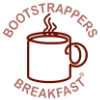Fluent Founder Roadmap
 We really like the work Beth Mckeon at Fluent is doing to clarify what a strong startup ecosystem needs from incubators, accelerators, working spaces, and startup oriented events. Her book “10 of 10” argues that we have to move beyond thinking that only “1 in 10” will make it to providing value to all of the startups in an ecosystem.
We really like the work Beth Mckeon at Fluent is doing to clarify what a strong startup ecosystem needs from incubators, accelerators, working spaces, and startup oriented events. Her book “10 of 10” argues that we have to move beyond thinking that only “1 in 10” will make it to providing value to all of the startups in an ecosystem.
For the past ten years, our communities have been testing a set of theories about how to best support startup activity – from events like Startup Weekend, to coworking spaces, to programs like accelerators. These programs and services all have one thing in common: they are all engineered to increase a startup’s opportunities for luck and serendipity. Almost no thought has been put into designing systems that predictably, repeatably create startup success.
We’ve optimized our spaces to increase collisions. We’ve measured our success, not with data, but with the number of mentors on our program roster. We’ve operated with the belief that our role as ecosystem builders is to convene the right mix of people, that in the gathering of smart, committed people magic will happen.
(And sometimes it does. Such is the way of magic and luck.)
But luck is what it looks like when you don’t know how to measure, experiment, and optimize to get the results you want. We’ve optimized for luck long enough.
Beth McKeon in “10 of 10″ (forthcoming in 2019)
There is a lot to be said for structured networking and it’s certainly one of the benefits of attending any Bootstrapper Breakfast in the world—or a “working for equity” structured networking event at the Lean Culture Meetup in Silicon Valley. We have seen a number of teams form in addition to useful business connections between startups and potential suppliers or customers.
Exercise at July 2019 Breakfasts in Silicon Valley
This model allows bootstrappers to define where they are in developing and refining their business. Instead of using the stage of funding (e.g. Seed, A Round, B Round, … ) to characterize the level of maturity a startup has reached, the Founder Roadmap looks at three broad stages:
- Validate: Should I pursue this particular idea?
- Test: Will customers pay me to solve this problem?
- Grow: What is the repeatable business model?
During our July breakfasts in Silicon Valley, we are going to do a 15 minute “3×5 card workshop” using the Founder Roadmap. Attendees will determine their stage and write down a key question they need to answer and the next action they will take to get answers. Those who want can share their answers for perspectives and insights from other attendees.
Original Fluent Introduction
Founders who focus on the right thing at the right time make the most progress. Use the Fluent Founder Roadmap to identify where you should focus your venture-building efforts.
- What question needs to be answered next?
- What assumptions do you have in each stage that need to be tested and validated?
These questions highlight the biggest risks in your business model and they influence each other. For
example, you want to ensure you have solid, well-validated answers to the Validate stage questions
before tackling the Test and Grow stage questions.
Validate Stage
High Level Question: Should I pursue this particular idea?
Detailed questions to explore:
- Is there a problem worth solving?
- Are there potential customers who acutely experience this problem?
- Is the market big enough to build the kind of business we want?
- Are we the right team at the right time?
- Is this a business we want to run?
Action Step: Conduct customer discovery interviews. Consider Pretotyping approaches to test basic viability.
“There is one difference between theory and practice. Practice won’t let you forget anything or leave anything out. In theory problems are easily solved because you can leave something out.”
Charles F. Kettering
Test Stage
High Level Question: Will customers pay me to solve this problem?
Detailed questions to explore:
- What features does our prototype need to have to solve our customer’s problem?
- What features can we avoid building now while still creating the value we’ve promised?
- Will customers pay us to solve this problem this way?
Action Step: Test a very quick prototype or demo (Wizard of Oz, concierge, or other non-scalable testing techniques)
“Testing leads to failure, and failure leads to understanding.”
Burt Rutan
Grow Stage
High Level Question: What is the repeatable business model?
Detailed questions to explore:
- What is the repeatable, scalable process for creating paying customers?
- How do we reach new customers beyond our early adopters?
- What is our Go To Market strategy?
- What do we need to learn about revenue and costs to make our current and future strategies work?
- What features do we need to build into our core product now and in the future?
- Who could we partner with for distribution and/or investment?
Action Steps
- Run small cohort experiments with early adopters.
- Hire a team, build a product, and scale the business
“Sales people sell to meet quota, entrepreneurs sell to meet payroll.”
Sean Murphy
Originally developed in 2018 by Beth McKeon of Fluent, (Click here to download 2018 PDF version.) This version contains a number of small tweaks.

This work is licensed under a Creative Commons Attribution-ShareAlike 4.0 International License.
